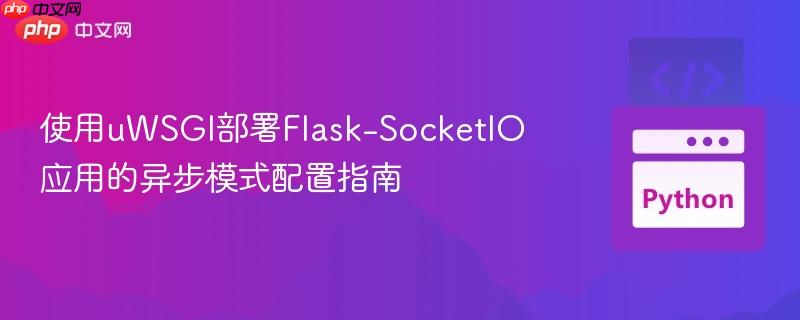
本文详细阐述了在uwsgi环境下部署flask-socketio应用时,如何正确配置异步模式以解决常见的`runtimeerror`和websocket连接失败问题。核心在于将`socketio`实例的`async_mode`明确设置为`gevent_uwsgi`,并建议采用单工作进程配合gevent实现高并发,而非多工作进程。
在构建基于WebSocket的实时应用时,Flask-SocketIO是一个强大且易于使用的库。然而,当将其与uWSGI等生产级WSGI服务器结合部署时,尤其是在涉及异步I/O和多进程配置时,可能会遇到一些挑战。本文将深入探讨如何正确配置Flask-SocketIO与uWSGI,以确保WebSocket服务稳定高效运行。
Flask-SocketIO依赖于底层的异步库来处理WebSocket连接。它支持多种异步模式,如eventlet、gevent、threading以及专门为特定WSGI服务器优化的模式。当Flask-SocketIO检测到系统中安装了eventlet或gevent等库时,它会尝试使用它们。然而,uWSGI本身也具备管理Gevent协程的能力。如果Flask-SocketIO尝试启动其自己的Eventlet或Gevent服务器,而uWSGI已经接管了事件循环,就会导致冲突,从而引发RuntimeError,例如“You need to use the eventlet server.”
为了在uWSGI环境中正确运行Flask-SocketIO,关键在于明确告知SocketIO使用uWSGI的Gevent集成。这通过在SocketIO构造函数中设置async_mode='gevent_uwsgi'来实现。
将SocketIO的初始化修改为使用gevent_uwsgi异步模式。
from flask import Flask
from flask_socketio import SocketIO, send, emit
import os
app = Flask(__name__)
# 明确指定异步模式为 'gevent_uwsgi'
# logger和engineio_logger有助于调试
socketio = SocketIO(app, logger=True, engineio_logger=True, cors_allowed_origins='*', async_mode='gevent_uwsgi')
@socketio.on('connect')
def connected():
"""处理客户端连接事件"""
print('-'*30, '[connect]', '-'*30)
print(f"Client connected: {os.getpid()}") # 打印当前进程ID
@socketio.on('message')
def handle_message(data):
"""处理客户端发送的消息"""
print('-'*30, '[message]', '-'*30)
print(f'Received message: {data} in PID: {os.getpid()}')
send(data) # 将收到的消息回显给发送方
@socketio.on_error() # 捕获所有SocketIO错误,包括连接错误
def handle_error(e):
"""处理SocketIO层面的错误"""
if isinstance(e, Exception):
print('An error occurred:', str(e))
# 可以在此处记录错误或执行其他必要操作
@app.route("/")
def hello():
"""标准的HTTP路由,用于测试应用是否启动"""
return "Connected"
if __name__ == '__main__':
# 在开发环境中使用socketio.run,它会自动选择合适的异步服务器
# 生产环境部署时,通常由uWSGI来运行app
socketio.run(app, port=5000) # 注意:此行仅用于开发测试,生产环境由uWSGI启动对于Flask-SocketIO应用,最佳实践是运行单个uWSGI工作进程,并利用Gevent的协程能力来处理成千上万的并发连接。尝试使用多个工作进程(processes > 1)而不引入消息队列(如Redis)来同步不同进程间的SocketIO事件,会导致WebSocket连接在不同进程间漂移,从而出现消息丢失或连接中断的问题。
[uwsgi] # 项目根目录 chdir = /home/user/websocket # 指定WSGI模块和可调用对象 module = websocket:app callable = app # 使用Gevent异步模式,设置协程数量 gevent = 1000 # 根据实际需求调整协程数量,通常数百到数千 # 推荐使用单工作进程,利用Gevent处理并发 processes = 1 threads = 1 # 在Gevent模式下,线程数通常设为1或不设 # 监听HTTP请求的端口 http-socket = :15000 # Unix套接字,用于Nginx等反向代理(如果使用) # socket = /home/user/websocket/uwsgi.sock # chmod-socket = 664 # 用户和组(根据实际情况修改) uid = user gid = user # 启用主进程管理 master = true # 退出时清理套接字 vacuum = true # 自动重新打开日志文件 log-reopen = true # 进程终止时杀死所有worker die-on-term = true # 启用Python 3插件 plugin = python3 # 虚拟环境路径 virtualenv = /home/user/websocket/web # 启用HTTP WebSockets支持(uWSGI 2.0.17+) # 对于gevent_uwsgi模式,uWSGI会自行处理WebSocket升级,通常不需要显式设置 # http-websockets = true
注意事项:
在项目根目录下执行:
uwsgi --ini uwsgi.ini
如果一切配置正确,你将看到uWSGI启动,并加载Flask-SocketIO应用,不再出现RuntimeError。
客户端保持不变,它会尝试连接到服务器并发送消息。
<!DOCTYPE html>
<html>
<head>
<title>Flask SocketIO Client</title>
<script src="https://cdn.socket.io/4.0.0/socket.io.min.js"></script>
</head>
<body>
<h1>Flask SocketIO Client</h1>
<input type="text" id="messageInput" placeholder="Type a message...">
<button onclick="sendMessage()">Send</button>
<div id="messages"></div>
<script>
// 确保这里的地址和端口与uWSGI配置的http-socket一致
var socket = io('http://localhost:15000');
socket.on('connect', function() {
console.log('Connected to the server.');
document.getElementById('messages').innerText += 'Connected to the server.\n';
});
socket.on('message', function(data) {
console.log('Received message:', data);
document.getElementById('messages').innerText += 'Received: ' + data + '\n';
});
socket.on('disconnect', function() {
console.log('Disconnected from the server.');
document.getElementById('messages').innerText += 'Disconnected from the server.\n';
});
socket.on('connect_error', (error) => {
console.error('Connection Error:', error);
document.getElementById('messages').innerText += 'Connection Error: ' + error.message + '\n';
});
function sendMessage() {
var message = document.getElementById('messageInput').value;
if (message) {
console.log('Sending message:', message);
socket.emit('message', message);
document.getElementById('messageInput').value = '';
}
}
</script>
</body>
</html>这个简单的Flask应用用于提供index.html文件,与SocketIO服务器分开运行。
from flask import Flask, render_template
app = Flask(__name__)
@app.route('/')
def index():
return render_template('index.html')
if __name__ == '__main__':
# 运行在与SocketIO服务器不同的端口
app.run(port=5001, debug=True)启动client.py后,访问http://localhost:5001,打开浏览器控制台,你应该能看到WebSocket成功连接,并能正常发送和接收消息。
通过遵循上述配置和最佳实践,可以有效解决Flask-SocketIO在uWSGI部署中遇到的异步模式冲突和WebSocket连接问题,构建出稳定、高性能的实时Web应用。
以上就是使用uWSGI部署Flask-SocketIO应用的异步模式配置指南的详细内容,更多请关注php中文网其它相关文章!

每个人都需要一台速度更快、更稳定的 PC。随着时间的推移,垃圾文件、旧注册表数据和不必要的后台进程会占用资源并降低性能。幸运的是,许多工具可以让 Windows 保持平稳运行。

Copyright 2014-2025 https://www.php.cn/ All Rights Reserved | php.cn | 湘ICP备2023035733号